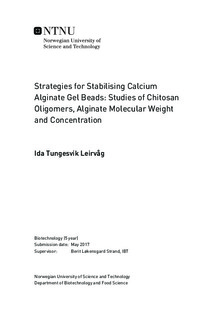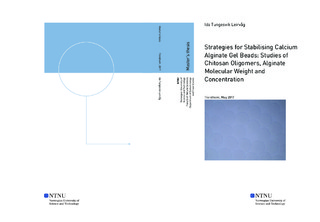| dc.description.abstract | Microencapsulation of cells or tissues in alginate-based capsules is the most commonly applied technique for immunoisolation. However, the biocompatibility of the capsules and their long-time stability under physiological conditions are two major problems related to cell encapsulation. Alginate is a linear binary copolymer consisting of β-D-mannuronic acid and α-L-guluronic acid linked by 1,4-glycosidic bonds, and is known to form gels with divalent ions like calcium. To increase the stability of alginate gel beads in physiological solutions, a polycation layer has traditionally been used to coat the alginate gel beads. However, most polycations are toxic to cells and the polycation layer have been associated with cellular overgrowth. Recently, alginates isolated from Laminaria hyperborea leaf with intermediate guluronic acid content was found to be highly biocompatible. However, gels prepared from alginates with intermediate guluronic acid content are known to exhibit lower mechanical strength and stability compared to alginate gels rich in guluronic acid.
In the present work, the stability and mechanical strength of L. hyp. leaf alginate gels were investigated to potentially provide a strategy to increase the stability of leaf alginate gel beads. The possibilities of generating leaf alginate gel beads crosslinked with calcium and chitosan oligomers were investigated, and the stability in terms of size and polymer leakage of the alginate-CO gel beads was studied. The mechanical properties in terms of Young s modulus and rupture strength were investigated for L. hyp. leaf alginate gel cylinders of varying molecular weights and concentrations, where gel cylinders prepared from low molecular weight L. hyp. stipe alginate were included as a reference. The effect of increasing the alginate concentration with very low molecular weight leaf or stipe alginate was also studied. In addition, syneresis was measured for all the alginate gel cylinders. Furthermore, the stability of low molecular weight L. hyp. leaf alginate gel beads in saline, in terms of swelling and polymer leakage, was investigated. High molecular weight L. hyp. leaf was included in the study for comparison. The chemical compositions of the leaked alginate from alginate-CO gel beads and low molecular weight leaf alginate gel beads were determined by 1H-NMR. For the low molecular weight leaf alginate gel beads, average molecular weights of the leaked alginates were obtained with SEC-MALLS.
Introducing chitosan oligomers into the crosslinking of alginate gel beads with calcium had a minor stabilizing effect with respect to size at pH 5.0, whereas alginate-CO gel beads prepared at pH 6.5 showed no stabilizing effect, compared to alginate gel beads gelled only with calcium. At pH 5.0, both alginate and chitosan oligomers are fully charged, hence expected to form strong interactions. The leaked alginate from the alginate-CO gel beads had a similar chemical composition to the starting material of alginate. Increasing the alginate concentration for the high and low molecular weight leaf alginate gel cylinders led to higher gel strength in terms of Young s modulus and rupture strength. The Young s modulus of the alginate gels were independent of the molecular weight in the given range (Mw = 115-200 kDa), while rupture strength increased with increasing molecular weight in the same range. Syneresis of the alginate gels decreased with increasing alginate concentration and decreasing molecular weight. The size stability of low molecular weight L. hyp. leaf alginate gel beads increased with increasing alginate concentration. No significant difference was seen between the 1.8 % (w/v) low and high molecular weight leaf alginate gel beads with regards to size stability. The degree of polymer leakage decreased with increasing alginate concentration and increasing molecular weight. The leaked materials from the low molecular weight leaf alginate gel beads were enriched in mannuronic acid compared to the starting material of alginate.
Increasing the alginate concentration of the L. hyp. leaf alginate gel beads showed promising results with regards to increasing stability of the gel beads. The molecular weight of the alginate had only minor effects on the stability. Introducing chitosan oligomers into the crosslinking of alginate with calcium had a slightly stabilizing effect at pH 5.0. However, pH 5.0 might compromise the viability of the cells being encapsulated. | |

